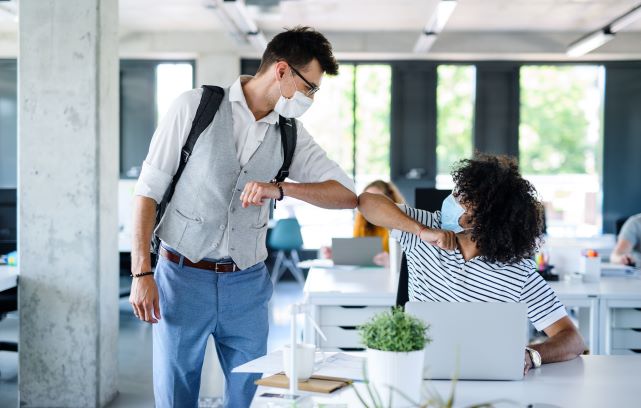
World Mental Health Day is an opportunity to reflect on the link between employee mental well-being and a well-designed, repurposed office environment
The ‘new normal’ we are all living in has placed enormous pressure on mental well-being. However, it has also heightened awareness and support to build and maintain mental well-being among employees, in particular. “It is possible to stay well by continuously building on this in small, consistent ways,” reflects Andile Rapiya, COO: Human Capital & Communications of leading Pan-African professional real-estate services provider Broll Property Group.

As South Africa looks to celebrate World Mental Health Day on Sunday 10 October, Andile explains that employees can best maintain a work-life balance by, firstly, being aware of the quality of their own mental well-being and, secondly, the impact of work-life interaction on this. “Increased awareness comes about by opening up about it and obtaining and sharing information on the topic,” says Andile.
Therefore, it is important for employees to educate themselves from trustworthy sources other than social media. Engage with professionals to assist you if you or people close to you have concerns about your mental well-being. Do not take mental well-being for granted. Work at it constantly by maintaining some basic essentials such as sleeping well, moving enough, eating in a balanced and nutritious way, quieting your mind regularly, maintaining supporting interpersonal relationships on a personal and work basis, and being open to learning new things.
An example of such a mental well-being initiative is the ‘Core Series’ of motivational and inspirational webinars launched by Broll in July to help its employees navigate the ‘new normal’. “We had a combination of teams working from home and the office. The various lockdown levels meant that most teams effectively had hybrid working models in place already. However, the pressure of the past 18 months was certainly the same for all of us, and we needed to ensure our employees were strengthening their personal core,” says Andile.
‘Strengthening the core’ is a key theme of Broll’s forward-looking five-year strategy launched by Group CEO Malcolm Horne earlier this year. The ‘Core Series’ speaks directly to employee well-being, a strategic priority of the Human Capital cluster within Broll. It was designed with the aim of shoring up employees’ mental reserves with a focus on mental wellness, emotional resilience, financial well-being and healthy productivity. The weekly Zoom sessions were hosted by an invited speaker, respected in their field, to address the topic of the week.
Topics were selected by means of a detailed pre- and mid-survey to gauge what main concerns employees had in both their work and personal situations, and how they were coping, staying alert and well in the face of the ongoing challenges posed by the pandemic. An ‘Inner Core’ Zoom workshop was held every second Thursday where the Broll leadership discussed that week’s topic and how best to equip their teams with the necessary skills to remain resilient. The overwhelmingly positive response to the 12-week series has resulted in it being extended to December.
Some of the speakers and topics included: Erik Vermeulen on ‘Tips to Shift Your Mind From A State Of Resilience to Endurance’, Ingra Du-Buisson on ‘Building your Well-being and Well-doing Super Power’, Dr. Nokukhanya Khanyile on ‘Mental Health Matters’, Dr. Natasha Winkler-Titus on ‘Mindfulness’, Francoise Harrison on ‘How the Covid-19 Pandemic has Affected Children, and What We Can Do to Assist Them’, Dr. Stanley Arumugam on ‘Grief at Work’, Tanya Muir on ‘Sleep: Your Super Power for Better Health and Well-being, and Dr. Phatokuhle Zondi, a sports and exercise medicine physician, on health and well-being.
“We just do not realise the extent of the physical and psychological impact that has been exerted on employees since March last year. People have lost loved ones, friends, livelihoods, jobs.” The fact that Broll has maintained business continuity throughout the course of the pandemic is testament to the true core strength of the Group. “This is largely due to our most important asset, which is our people,” says Andile.
Looking back to March 2020, employees initially adapted quite quickly to the ‘new normal’, says Lianie Minny, Managing Director, Internal Developers, Cushman & Wakefield I BROLL. However, the aftermath of extended working from home (WFH) is only surfacing now after a prolonged period of disengagement from the office and colleagues, leading to a debate about how to develop workplace strategies for the future.

For example, a way forward is to look at having access to a workplace ‘away from home’ as encouraging the uptake of potential ‘third spaces’ that sit between work and home. These include coffeeshops and meetings out of the office. In essence, providing employees with the choice to work from anywhere, and not only from home, stands to enhance mental health significantly.
Mental health issues such as anxiety can cause employees to lose concentration, making it difficult to prioritise and carry out day-to-day activities. Employees’ stamina is also affected, meaning it is a constant battle to meet deadlines and remain productive. “We know that the work environment has a significant impact on employee mental wellness, productivity, job turnover and overall profitability,” says Lianie.
There are also top-down policy changes that may benefit a workforce, such as introducing an element of flexi-time into WFH so that employees can still get sufficient exercise and attend to their personal day-to-day tasks, and completing a full day of work. Here WFH options can vary from a full move to a home office or only one or two days per week.
The key to understanding the future workplace and way of working is that it needs to remain flexible. A hybrid way of working, in essence, allows employees to work from anywhere in an organic and or structured manner, keeping the workplace open, collaborative and multi-functional. The workplace should be able to adapt and evolve continuously and not create a new ‘static’ norm. For example, workplace performance can be improved by designing for access to natural light for all employees, improving the air quality and temperature control, encouraging movement in and around the office, providing ergonomic furniture in a variety of work settings and providing mentorship and coaching.
What has emerged recently as the national vaccination programme gains momentum, and there is renewed talk of a ‘return to the office’, is a clear understanding that the workplace is not only a place of work. “It is a place of collaboration; it is the heart of the business and reflects the rhythm of its culture. It is a place where we share ideas with like-minded people and create solutions together. Access to a healthy work environment allows for self-expression, autonomy and a sense of control; it allows us to read body language, build camaraderie and share enthusiasm and generate contagious energy. All of these elements are fundamental in maintaining good mental health,” says Lianie.
Now that a return to the office is on the cards, many corporates see the hybrid model as the workplace strategy of the future. “A hybrid way of working is not only finding the right balance between returning to the office and WFH. In fact, it is much more than this,” says Lianie. Many businesses are looking for a more flexible property portfolio going forward, whether complementing city centre hubs with regional hubs, using co-working spaces or managed serviced spaces for project teams.
The hybrid model extends further into the workplace itself, providing for a variety of workspaces and work activities. How the office itself is planned is also key to employee performance. “At the end of the day, employee well-being extends beyond mental health only. It is a combination of physical, social, phycological, intellectual and financial support that together affects our mental stability and balance,” says Lianie.
“Organisations will never be able to go back to the way things were before March 2020,” says Andile. Therefore, employers and employees have forged a new way of working that brings with it the benefits of flexibility and autonomy. “We should leverage these advantages going forward to build employee engagement and well-being, while managing and leading in a way that mitigates any disadvantages such as loneliness and distraction,” she concludes.
More news
- EMIRA BOOSTS ITS LQUIDITY WITH USD500M DEAL
- NAME CHANGE TO FUCHS AFRICA REFLECTS SUB-SAHARAN AFRICA FOOTPRINT
- REFRATECHNIK ASIA NEW ASSOCIATE CORPORATE MEMBER OF WCA
- PART 5: SA’S TRADE DILEMMA: A PODCAST DISCUSSION WITH DONALD MACKAY
- STATE-DRIVEN OPPORTUNITIES FOR SA CONSTRUCTION COMPANIES BUT MANAGING RISK IS A PRIORITY

